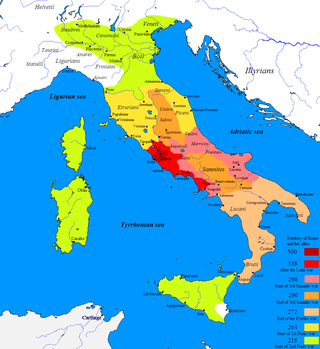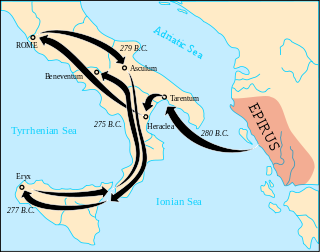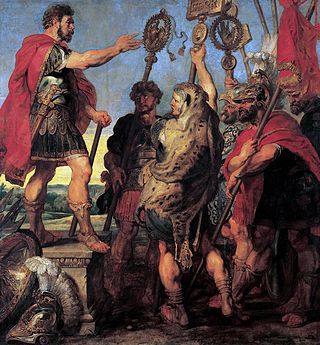
The Appian Way is one of the earliest and strategically most important Roman roads of the ancient republic. It connected Rome to Brindisi, in southeast Italy. Its importance is indicated by its common name, recorded by Statius, of Appia longarum... regina viarum . The road is named after Appius Claudius Caecus, the Roman censor who, during the Samnite Wars, began and completed the first section as a military road to the south in 312 BC.
During the 290s BC, Hellenistic civilization begins its emergence throughout the successor states of the former Argead Macedonian Empire of Alexander the Great, resulting in the diffusion of Greek culture throughout the Levant and advances in science, mathematics, philosophy, etc. Meanwhile, the Roman Republic is embroiled in war against the Samnites, the Mauryan Empire continues to thrive in Ancient India, and the Kingdom of Qin in Ancient China, the one which in the future will conquer its adversaries and unite China, begins to emerge as a significant power during the Warring States period.

Year 290 BC was a year of the pre-Julian Roman calendar. At the time it was known as the Year of the Consulship of Rufinus and Dentatus. The denomination 290 BC for this year has been used since the early medieval period, when the Anno Domini calendar era became the prevalent method in Europe for naming years.

The First, Second, and Third Samnite Wars were fought between the Roman Republic and the Samnites, who lived on a stretch of the Apennine Mountains south of Rome and north of the Lucanian tribe.

Samnium is a Latin exonym for a region of Southern Italy anciently inhabited by the Samnites. Their own endonyms were Safinim for the country and Safineis for the people. The language of these endonyms and of the population was the Oscan language. However, not all the Samnites spoke Oscan, and not all the Oscan-speakers lived in Samnium.

Lucius Cornelius Scipio Barbatus was one of the two elected Roman consuls in 298 BC. He led the Roman army to victory against the Etruscans near Volterra. A member of the noble Roman family of Scipiones, he was the father of Lucius Cornelius Scipio and Gnaeus Cornelius Scipio Asina and great-grandfather of Scipio Africanus.

Manius Curius Dentatus was a Roman general and statesman noted for ending the Samnite War and for his military exploits during the Pyrrhic War. According to Pliny, he was born with teeth, thus earning the surname Dentatus, "toothed."

The Battle of Heraclea took place in 280 BC between the Romans under the command of consul Publius Valerius Laevinus, and the combined forces of Greeks from Epirus, Tarentum, Thurii, Metapontum, and Heraclea under the command of Pyrrhus, king of Epirus. Although the battle was a victory for the Greeks, they incurred severe losses.
The Battle of Sentinum was the decisive battle of the Third Samnite War, fought in 295 BC near Sentinum, in which the Romans overcame a formidable coalition of Samnites, Etruscans, and Umbrians and Senone Gauls. The Romans won a decisive victory that broke up the tribal coalition and paved the way for the Romans' complete victory over the Samnites. The Romans involved in the battle of Sentinum were commanded by consuls Publius Decius Mus and Quintus Fabius Maximus Rullianus.

The Battle of Asculum was a poorly documented battle that took place near Asculum in 279 BC, and was thought to have lasted either one or two days, between the Roman Republic under the command of the consuls Publius Decius Mus and Publius Sulpicius Saverrio, and the forces of King Pyrrhus of Epirus. The battle took place during the Pyrrhic War, after the Battle of Heraclea of 280 BC, which was the first battle of the war. There exist accounts of this battle only by three ancient historians: Dionysius of Halicarnassus, Plutarch, and Cassius Dio. Asculum was in Lucanian territory, in southern Italy. The Battle of Asculum was the original "Pyrrhic victory". The result of the battle is not definitively known, with Plutarch stating that it was a pyrrhic Greek victory, Cassius Dio recording it as a Roman victory. The constituents of both armies are also poorly known, with each historian offering largely divergent estimates for the strength of the armies or the length of the battle.

The Pyrrhic War was largely fought between the Roman Republic and Pyrrhus, the king of Epirus, who had been asked by the people of the Greek city of Tarentum in southern Italy to help them in their war against the Romans.
The Battle of Beneventum was the last battle of the Pyrrhic War. It was fought near Beneventum, in southern Italy, between the forces of Pyrrhus, king of Epirus in Greece, and the Romans, led by consul Manius Curius Dentatus. The result was a Roman victory and Pyrrhus was forced to return to Tarentum, and later to Epirus.

Lucius Papirius Cursor was a celebrated politician and general of the early Roman Republic, who was five times consul, three times magister equitum, and twice dictator. He was the most important Roman commander during the Second Samnite War, during which he received three triumphs.
Quintus Fabius Q. f. M. n. Maximus Gurges, the son of Quintus Fabius Maximus Rullianus, was consul in 292, 276, and 265 BC. After a dissolute youth and a significant military defeat during his first consulate, he was given the opportunity to salvage his reputation through the influence of his father, and became a successful general, eventually holding the highest honours of the Roman state. He was slain in battle during his third and final consulate.

Publius Decius Mus, of the plebeian gens Decia, was a Roman consul in the years 312 BC, 308 BC, 297 BC and 295 BC. He was a member of a family that was renowned for sacrificing themselves on the battlefield for Rome.
The Battle of Tifernum was an important battle of the Third Samnite War, fought in 297 BC near Castropignano, either on the banks of the river Biferno or near the Matese mountains in the province of Campobasso, in what is now southern Italy, where the Romans overcame a determined Samnite army. The result would lead to the decisive Battle of Sentinum, which granted Rome the domination of central Italy.
Spurius Carvilius C. f. C. n., later surnamed Maximus, was the first member of the plebeian gens Carvilia to obtain the consulship, which he held in 293 BC, and again in 272 BC.
Gaius Junius Bubulcus Brutus was a Roman general and statesman, he was elected consul of the Roman Republic thrice, he was also appointed dictator or magister equitum thrice, and censor in 307 BC. In 311, he made a vow to the goddess Salus that he went on to fulfill, becoming the first plebeian to build a temple. The temple was one of the first dedicated to an abstract deity, and Junius was one of the first generals to vow a temple and then oversee its establishment through the construction and dedication process.

Lucius Postumius Megellus was a politician and general during the middle years of the Roman Republic. Reportedly an arrogant and overbearing man, he was elected consul in 305 BC. The Second Samnite War was ongoing, and as consul he led troops against the Samnites. He defeated them at the Battle of Bovianum and took the town of Bovianum, which caused the Samnites to sue for peace, ending the war. Megellus was awarded a triumph.
The Battle of Imbrinium was fought in 325 BC during the Second Samnite War between the Roman Republic, led by the magister equitum, Quintus Fabius Maximus Rullianus and the Samnites near Imbrinium, a city in Samnium.








